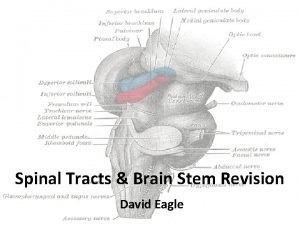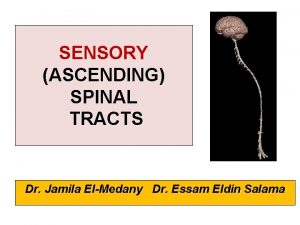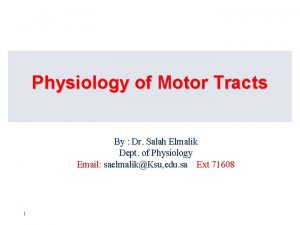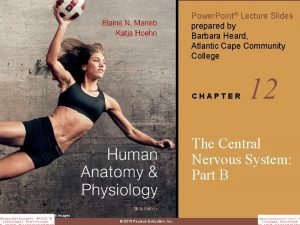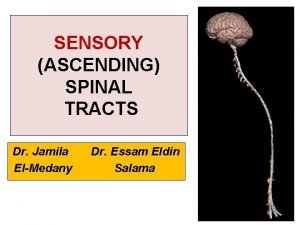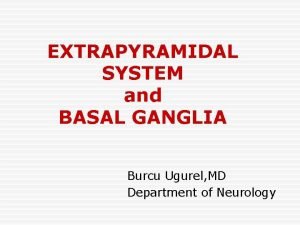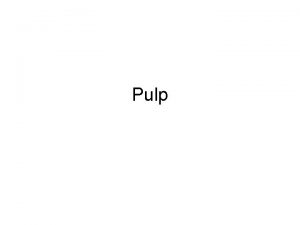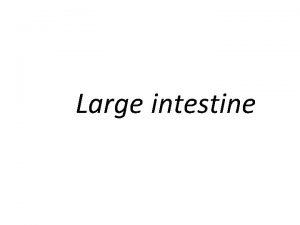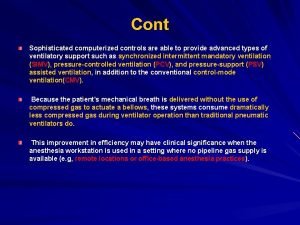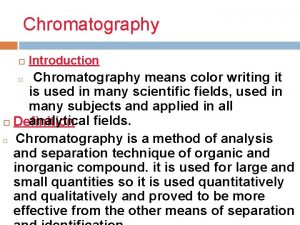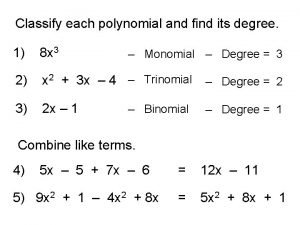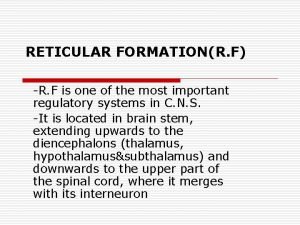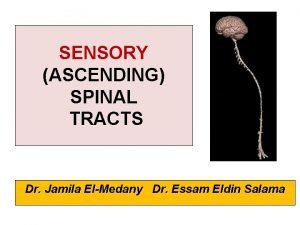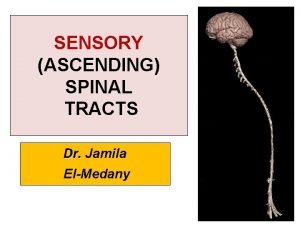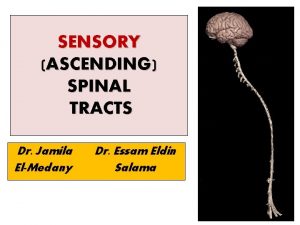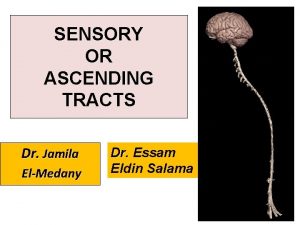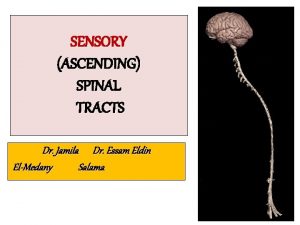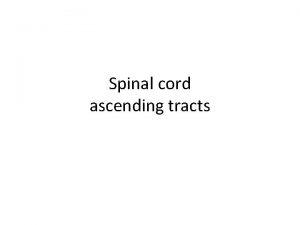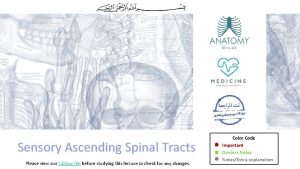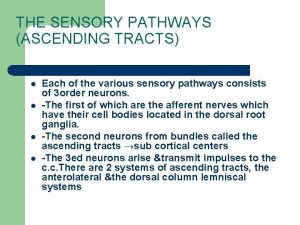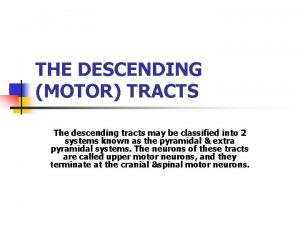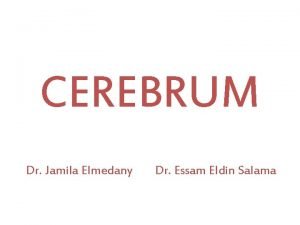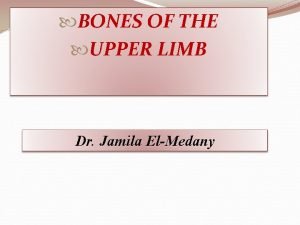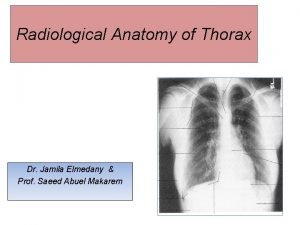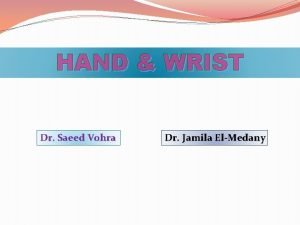SENSORY ASCENDING SPINAL TRACTS Dr Jamila ElMedany Dr
























- Slides: 24

SENSORY (ASCENDING) SPINAL TRACTS Dr. Jamila El-Medany Dr. Essam Eldin Salama

OBJECTIVES • By the end of the lecture, the student will be able to: • Define the meaning of a tract. • Distinguish between the different types of tracts. • Locate the position of each tract. • Describe the sensory pathway. • Identify the different sensory spinal tracts and their functions. • Identify the course of each of these tracts.

q The White matter of the spinal cord consists of q Ascending and Descending Nerve Fibers. q It is divided into Dorsal, Lateral & Ventral Columns or Funiculi. 3

WHITE MATTER TRACTS • Bundles or fasciculi of fibers that occupy more or less definite positions in the white matter. • They have the same Origin, • Termination and • carry the same Function.

CLASSIFICATION OF WHITE MATTER TRACTS • They are classified into: 1 - Short Tracts; intersegmental or propriospinal). Fibers occupy narrow band peripheral to the grey matter (fasciculus proprius) They interconnect adjacent or distant spinal segments And Permit intersegmental coordination

• 2 -Long Tracts: (a) Ascending (sensory or afferent). (b) Descending (motor or efferent). They serve to join the brain to the spinal cord.

q Ascending Tracts; • Carry impulses from pain, thermal, tactile, muscle and joint receptors to the brain. • Some of this information eventually reaches a conscious level (the cerebral cortex), • while some is destined for subconscious centers (e. g. the cerebellum).

• Pathways that carry information to a conscious level share certain common characteristics: • There is a sequence of Three Neurones between the peripheral receptors and the cerebral cortex.

The first-order neurone (or primary afferent neurone) enters the spinal cord through the dorsal root of a spinal nerve and its cell body lies in the dorsal root ganglion. The main fiber remains on the ipsilateral side of the cord and terminates in synaptic contact with the second-order neurone which lies either in the spinal grey matter or in the medulla oblongata of the brain stem.

• The axon of the second-order neurone crosses over (decussates) to the opposite side of the CNS and ascends to the thalamus, where it terminates. • The third-order neurone has its cell body in the thalamus. • Its axon passes to the somatosensory cortex of the parietal lobe of the cerebral hemisphere.

• Three major pathways carry sensory information: • Posterior column (Gracile & Cuneate fasciculi). • Anterolateral pathway (Spinothalamic tract). • Spinocerebellar pathway.

Dorsal Column • Contains two tracts; Fasciculus Gracilis (FG) & Fasciculus Cuneatus (FC) • Carry impulses concerned with proprioception and discriminative (fine)touch, from ipsilateral side of the body. • Contain the axons of primary afferent neurons that have entered cord through dorsal roots of spinal nerves. • FG contains fibers received at sacral, lumbar and lower thoracic levels, • FC contains fibers received at upper thoracic and cervical levels

Dorsal Column • Fibers ascend without interruption where they terminate upon 2 nd order neurons in nucleus gracilis and nucleus cuneatus • The axons of the 2 nd order neurons decussate in the medulla as internal arcuate fibers and ascend through the brain stem as medial lemniscus. • The medial lemniscus terminates in the ventral posterior nucleus of the thalamus (3 rd order neurons), • which project to the somatosensory cortex (thalamocortical fibers)

• Located lateral and ventral to the ventral horn. • Carry impulses concerned with; pain and thermal sensations (Lateral tract) and nondiscriminative touch and pressure (Anterior tract). • In brain stem, constitute the spinal lemniscus. • Information is sent to the primary sensory cortex on the opposite side of the body. Spinothalamic Tracts

q Function: • Carries pain & Temperature to thalamus and sensory area of the cerebral cortex. q Neurones: 3 Neurones • Neurone I: Small cells in the dorsal root ganglia. • Neurone II: Cells of substantia gelatinosa of Rolandi in the posterior (dorsal)horn. • Neurone III: Cells of (VP) nucleus of the thalamus. • The spinothalamic tract contains second-order neurones, the cell bodies of which lie in the contralateral dorsal horn. Lateral Spinothalamic Tract

Anterior Spinothalamic Tract q Function: • Carries crude touch & pressure to thalamus and sensory cortex. q Neurones: 3 Neurones • Neurone I: Medium sized cells in the dorsal root ganglia. • Neurone II: Cells of main sensory nucleus or (nucleus proprius). • Neurone III: Cells of VP nucleus of thalamus. q Effect of lesion: Loss of crude touch sensation below the level of the lesion.

q Syringomyelia, (widening of the central canal) leads to Loss of pain & temperature below the level of the lesion because the spinothalamic axons decussate to the opposite side of the cord by passing through the ventral white commissure, which lies ventral to the central canal of the cord, .

• The spinocerebellar system consists of a sequence of only two neurons; • Neurone I: Large cells of dorsal root ganglia. • Neurone II: cells of the nucleus dorsalis (Clark's nucleus). • Two tracts: Dorsal &Ventral • Located near the dorsolateral and ventrolateral surfaces of the cord. • Contain axons of the second order neurons. • Carry information derived from muscle spindles, Golgi tendon organs and tactile receptors to the cerebellum. • for the control of posture and • coordination of movements. Spinocerebellar Tracts

Posterior Spinocerebellar Tract • Present only above level L 3 • The cell bodies of 2 nd order neuron lie in Clark’s column • Axons of 2 nd order neuron terminate ipsilaterally (uncrossed) in the cerebellar cortex by entering through the inferior cerebellar peduncle. • Posterior spinocerebellar tract convey sensory information to the same side of the cerebellum.

Ventral (Anterior)Spinocerebellar Tract • The cell bodies of 2 nd order neuron lie in base of the dorsal horn of the lumbosacral segments. • Axons of 2 nd order neuron cross to opposite side, ascend as far as the midbrain, and then make a sharp turn caudally and enter the superior cerebellar peduncle. • The fibers cross the midline for a second time within the cerebellum before terminating in the cerebellar cortex. • Ventral spinocerebellar tract convey sensory information to the same side of the cerebellum.

• Ascends in the anterolateral part, in close association with spinothalamic system. • Primary afferents reach dorsal horn through dorsal roots and terminate on 2 nd order neurons • The cell bodies of 2 nd order neuron lie in base of the dorsal horn. • Axons of 2 nd order neuron cross to opposite side, and project to the periaquiductal gray matter and superior colliculus in the midbrain. • Involved in reflexive turning of the head and eyes toward a point of cutaneous stimulation. Spinotectal Tract

Indirect spinocerebellar pathway (spino-olivocerebellar) Impulses from the spinal cord are relayed to the cerebellum via inferior olivary nucleus. Conveys sensory information to the cerebellum. Fibers arise at all levels of the spinal cord. Contribute to movement coordination associated primarily with balance. Spino - olivary Tract

Spinoreticular Tract • Originates in laminae IV-VIII • Contains uncrossed fibers that end in medullary reticular formation & • crossed & uncrossed fibers that terminate in pontine reticular formation. • Forms part of the ascending reticular activating system. • Involved in arousing consciousness in the reticular activating system through cutaneous stimulation.

Thank you
 Ascending tracts
Ascending tracts Spinoreticular tract
Spinoreticular tract First second and third order neurons
First second and third order neurons Reticulospinal tract function
Reticulospinal tract function Our old trusty truck cranial nerves
Our old trusty truck cranial nerves Exercise 15 spinal cord and spinal nerves
Exercise 15 spinal cord and spinal nerves Inferior gluteal nerve
Inferior gluteal nerve Figure 13-2 spinal nerves labeled
Figure 13-2 spinal nerves labeled Jamila piracci
Jamila piracci Jamila edwards
Jamila edwards Adjectives in arabic
Adjectives in arabic Extrapyramidal tract
Extrapyramidal tract Pyramidal tract
Pyramidal tract Function medulla oblongata
Function medulla oblongata Cerebellar signs
Cerebellar signs Pyramidal and extrapyramidal system
Pyramidal and extrapyramidal system Cell free zone of pulp
Cell free zone of pulp Ascending colon relations
Ascending colon relations Haustrum of colon
Haustrum of colon Descending bellows
Descending bellows Afferent arteriole
Afferent arteriole Ascending chromatography
Ascending chromatography Identify the polynomial written in ascending order.
Identify the polynomial written in ascending order. Anatoman
Anatoman Reticular system
Reticular system
